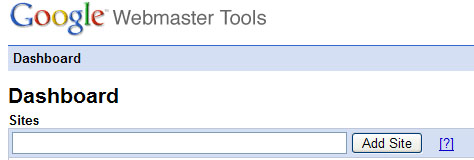How To Increase Blog Traffic part 1: Google Webmaster Tools
By StrangeWork.com: I was asked by a couple friends of mine, Brooke and Toni, about how to get more traffic to their blogs. I decided to write a quick tutorial to help everyone learn a couple techniques I use to help rank higher in search engines.
Google Webmaster Tools
Google Webmaster Tools have been around for a while now, but many bloggers do not know how to utilize these tools to increase blog traffic. I use two quick and easy techniques, Sitemaps and Robots.txt, that I will discuss in this article.
Add Your Blog Sitemap
Step 1: Find Your Blog Sitemap
A blog sitemap is an XML feed of every link available on your blog. By default most blogging platforms, including WordPress, Blogger, and Moveable Type, have an RSS feed preinstalled on your blog. An RSS feed is a feed made using XML so there is no setup, it’s already there!
Examples for popular blog platforms:
WordPress – http://www.blogname.com/rss
Blogger – http://blogname.blogspot.com/feeds/posts/default
Moveable Type – http://www.blogname.com/atom.xml
Feed Burner – http://feeds.feedburner.com/blogname
Just replace blogname with the name of your site. Use the examples above to figure out what your feed URL is. You will need it in the next step.
Step 2: Load your blog sitemap in to Google Webmaster Tools
Visit the Google Webmaster Tools Home Page and login to your Google account. If you don’t have a Google account, register one real quick.
Once logged in to the Tools dashboard you will see a textbox at the top allowing you to add your blog:
Type your site URL in and click the “Add Site” button.
Next you will need to Verify your blog to Google. Click the “Verify your site” link and follow the instructions given by Google.
Once you have verified your blog click the “Sitemaps” menu item from the left hand side and click the “Add A Sitemap” link.
Select “Add General Web Sitemap” when asked to Choose Type. You will then see a text box to enter in your RSS feed URL like this:
Enter your feed URL and click the “Add General Web Sitemap” button and your done! Once Google verifies your feed is in the proper format they will then crawl your feed daily to look for new links.
The benefit of providing Google with a sitemap is to help them improve how they crawl your blog. Over time you will start to notice an increase in search engine ranking which will result in more traffic.
Add Your Robots.txt File
Step 1: Update/create your robots.txt file
A robots.txt file is a small text file placed on your blogs web server that tells search engines what they are allowed, and not allowed, to index on your blog. Most blogs come with a robots.txt file preinstalled. Check to see if your blog has one by visiting the following URL on your blog:
http://www.blogname.com/robots.txt
Just replace blogname with the name of your site. We are going to create a new robots.txt file so it doesn’t matter if you do not currently have a robots.txt file on your blog.
Create a text file named robots.txt on your desktop. Enter the following code in to your newly created file:
User-agent: *
Disallow:
Sitemap: http://www.blogname.com/sitemap.xml
User-agent: * – indicates to all search engines they are allowed to crawl your site
Disallow: – incidates what URLs to exclude from being crawled by search engines. Since we are not entering a value to the right we are telling all search engines to crawl everything on your blog
Sitemap: http://www.blogname.com/sitemap.xml – indicates to the search engines where your sitemap is located. Use the sitemap link from the previous tip.
Save your file and upload to the root directory of your server. Google looks for a robots.txt file on your blog once a day. You can verify that Google finds your file by visiting the following Webmaster Tool section:
Dashboard > Tools > Analyze robots.txt
That’s it! Now all search engines will know where your sitemap is located from your robots.txt file. The major benefit of this is to help search engines find your new posts and links easier.
Google Webmaster Tools offer some really great statistics about how Google crawls and indexes your blog. Make sure you poke around in the other sections.
To install a true Google Sitemap be sure to check out the Google Sitemap Generator Plugin for WordPress.
I hope you find these tips helpful! Stay tuned for part 2.




